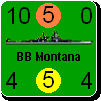ORIGINAL: marcuswatney
If inconsequential islets like St Eustatius are given an identifying '(Ned)' then I think larger islands like Dominica should be given something immediately visible without needing to hover the cursor.
I added "(Ned)" to St Eustatius because it was lost amongst French & British islands. I did not add the owning country's initial after all islands, because it would clutter the map too much.
But I also feel that at present the eastern Caribbean is very cluttered with large red names and many red political boundaries which all draw the eye away from the islands themselves and the terrain to be fought over.
One solution would be to perhaps keep the present red font for independent nations like Haiti and the Dominican Republic, but user a smaller one (or mixed upper and lower case) for colonies.
I prefer to have a consistent naming scheme, where a size & color means something.
And why does tiny St Bathélemy appear when the dominant island in that hex is (British) Anguilla? Anguilla is an island well known to Britons of my age since we invaded it in 1969 with London bobbies. (And St Bathélemy is 100 km from Barbuda so a crossing arrow is inappropriate).
This island was in a hex belonging to French Antilles, from the CWiF days. So, naming one of its islands for an English island looked weird. Moreover, this place is cluttered with lots of islands that the hexgrid can't show all of them properly with their rightfull owned country. So I chose to put the St Bathélemy place, that is famous at least in France for its rich visitors nowadays. I could have put St Martin too, which is in the same hex. But St Martin is both Dutch & French, so putting St Bathélemy looks OK.
The crossing arrow is not necessarily between St Bathélemy and Barbuda, it is between both hexes. It may be other islands.
If we replaced St Bathélemy with Anguilla then the British Antilles would consist of six islands in a single sweep (plus Dominica), all a single territory whose control switches with St John's (surely not 'Saint Johns'?) That would make the map look a lot less confused.
I prefer to stay minimalistic with the changes from the original map, and to leave it this way. The countries were decided in the CWiF days, and we inherited from them that way. I trust the original map designer here. His take is plausible, even if cluttered.
St Kitts was called St Christopher in 1936, and St Eustatius is very close: the crossing arrow is justified, but please move the image of the island closer to St Kitts.
On my 1940 map from the Collier Atlas, it is named St Kitts. Also it is shorter, and personaly I know it better with this name. Granted the drawn St Eustatius looks far from St Kitts, but this hex also houses Saba (not drawn) that is quite far. I think we won't redraw this just because St Eustatius is too far away.
St Lucia is very British, yet it is identified as French because of a small amount of Martinique crossing over into its hex. St Lucia and Dominica are the same size, with Martinique just a little bit bigger. I would think all three should be one-hex islands, but if for game purposes it is desirable for Martinique to be two hexes (and there may be good reasons to invade it if it is Vichy French) then please shift the image east a little and have the second Martinique hex the one to the southeast.
I think that this is too much work for little result here. I know St Lucia is British (it was French before), but the place here is quite packed tight, and shifting Martinique to the east as you describe would look weird.
The unnamed US Virgin islands are Isle de Vieques and Santa Cruz.
I'll add these names.
I have the latter as Saint Croix Island on my 1940 Collier Atlas map. Would it be good ? Saint Croix means the same as Santa Cruz.
I have the former as simply Vieques.
The unnamed British Antilles islands at the northwestern end of the chain are Virgin Gorda (next to St Thomas) and Anegada.
I'll add the former. The latter is already on the map.
Here are the Bahamas. Also they are shown in Steve's posts of page 18 in this thread. Bermuda are visible in post #515.












